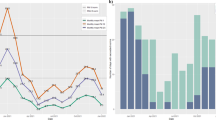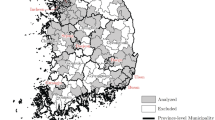Abstract
Much work has been done in the context of the hedonic price theory to estimate the impact of air quality on housing prices. Research has employed objective measures of air quality, but only slightly confirms the hedonic theory in the best of cases: the implicit price function relating housing prices to air pollution will, ceteris paribus, be negatively sloped. This paper compares the performance of a spatial Durbin model when using both objective and subjective measures of pollution. On the one hand, we design an Air Pollution Indicator based on measured pollution as the objective measure of pollution. On the other hand, the subjective measure of pollution employed to characterize neighborhoods is the percentage of residents who declare that the neighborhood has serious pollution problems, the percentage being referred to as residents’ perception of pollution. For comparison purposes, the empirical part of this research focuses on Madrid (Spain). The study employs a proprietary database containing information about the price and 27 characteristics of 11,796 owner-occupied single family homes. As far as the authors are aware, it is the largest database ever used to analyze the Madrid housing market. The results of the study clearly favor the use of subjective air quality measures.





Similar content being viewed by others
Notes
Version 3 of MCLUST for R is available as a contributed package (MCLUST) in the R language. It can be obtained from CRAN at http://cran.r-project.org/web/packages/mclust/index.html.
Should the null is rejected, the two-stage least squares (TSLS) method should be used because the estimates it produces are consistent (Anselin and Lozano-Gracia 2008). Instruments are not only needed for the API but also for the spatial lag of the endogenous variable Wy. It is common practice in the literature (Kelejian and Robinson 1993; Kelejian and Prucha 1998; Anselin 2007) to take the successive powers of \( {\mathbf{WX}}:\left\{ {{\mathbf{WX}},{\mathbf{W}}^{2} {\mathbf{X}},{\mathbf{W}}^{3} {\mathbf{X}}, \ldots ,{\mathbf{W}}^{p} {\mathbf{X}}} \right\} \) as instruments for Wy, and longitude and latitude coordinates as instruments for the API (Anselin and Lozano-Gracia 2008). The API indicator is excluded from the instruments to avoid endogeneity bias.
The results are practically the same for the API-model.
References
Anselin L (1988) Spatial econometrics: methods and models. Kluwer, Boston
Anselin L (2007) Spatial econometrics. In: Mills T, Patterson K (eds) Palgrave handbook of econometrics. Vol 1: Econometric theory. Palgrave-MacMillan, London
Anselin L, Le Gallo J (2006) Interpolation of air quality measures in hedonic house price models: spatial aspects. Spatial Econ Anal 1(1):31–52
Anselin L, Lozano-Gracia N (2008) Errors in variables and spatial effects in hedonic house price models of ambient air quality. Empirical Econ 34(1):5–34
Banzhaf HS (2005) Green price indices. J Environ Econ Manag 49(2):262–280
Berezansky B, Portnov BA, Barzilai B (2010) Objective vs. perceived air pollution as a factor of housing pricing: a case study of the greater Haifa metropolitan area. J Real Estate Lit 18(1):99–124
Bivand R (2010) spdep Spatial dependence: weighting schemes, statistics and models. R package version 0.5-24. Available in http://CRAN.R-project.org/package=spdep
Boyle MA, Kiel KA (2001) Survey of house price hedonic studies of the impact of environmental externalities. J Real Estate Lit 9(2):117–144
Brasington DM, Hite D (2005) Demand for environmental quality: a spatial hedonic analysis. Reg Sci Urban Econ 35(1):57–82
Can A (1990) The measurement of neighborhood dynamics in urban house prices. Econ Geogr 66(3):254–272
Can A (1992) Specification and estimation of hedonic housing price models. Reg Sci Urban Econ 22(3):453–474
Chay KY, Greenstone M (2005) Does air quality matter? Evidence from the housing market. J Polit Econ 113(2):376–424
Fraley C, Raftery E (1999) MCLUST: software for model-based cluster analysis. J Classif 16(2):297–306
Fraley C, Raftery E (2002) Model-based clustering, discriminant analysis and density estimation. J Am Stat Assoc 97(458):611–631
Fraley C, Raftery E (2010) MCLUST version 3 for R: normal mixture modeling and model-based clustering. Technical Report No. 504. Department of Statistics, University of Washington
Freeman AM III (1993) The measurement of environmental and resource values. Theory and methods. Resources for the Future, Washington
Hausman JA (1978) Specification tests in econometrics. Econometrica 46(6):1251–1271
Hendrix ME, Hartley PR, Osherson D (2005) Real estate values and air pollution: measured levels and subjective expectations. Discussion Paper, Rice University
Jackson T (2001) The effects of environmental contamination on real estate: a literature review. J Real Estate Lit 9(2):93–116
Jacquemin B, Sunyer J, Forsberg B, Götschi T, Bayer-Oglesby L, Ackermann-Liebrich U, de Marco R, Heinrich J, Jarvis D, Torén K, Künzli N (2007) Annoyance due to air pollution in Europe. Int J Epidemiol 36(4):809–820
Kelejian HH (2008) A spatial J-test for model specification against a single or a set of nonnested alternatives. Lett Spatial Res Sci 1(1):3–11
Kelejian HH, Prucha I (1998) A generalized spatial two stages least squares procedures for estimating a spatial autoregressive model with autoregressive disturbances. J Real Estate Finance Econ 17(1):99–121
Kelejian HH, Prucha I (2010) Specification and estimation of spatial autoregressive models with autoregressive and heteroskedastic disturbances. J Econom 157(1):53–67
Kelejian HH, Robinson I (1993) A suggested method of estimation for spatial interdependent models with autocorrelated errors and an application to a country expenditure model. Pap Reg Sci 72(3):297–312
Kim CW, Phipps TT, Anselin L (2003) Measuring the benefits of air quality improvement: a spatial hedonic approach. J Environ Econ Manag 45(1):24–39
LeSage J, Page RK (2009) Introduction to spatial econometrics. Chapman & Hall, New York
Minguez R, Fernández-Avilés G, Montero JM (2010) Does air pollution affect the price of housing? A joint geostatistics and spatial econometric perspective. In: Mladenov M, Psarris K, Mastoraskis N, Caballero A, Vachtsevanos G (eds) Development, energy, environment, economics. WSEAS Press, Tenerife
Mitchell RC, Carson RT (1989) Using samples to value public goods. The Johns Hopkins University Press, Washington
Montero JM, Fernández-Avilés G (2009) How to include environmental quality kriged indexes in hedonic housing price models. Pol J Environ Stud 18(5B):149–158
Montero JM, Larraz B, Chasco C (2010) Building an environmental quality index for a big city: a spatial interpolation approach combined with a distance indicator. J Geogr Syst 12(4):435–459
Murthy MN, Gulati SC, Banerjee A (2009) Hedonic property prices and valuation of benefits from reducing urban air pollution in India. Delhi Discussion Papers, 61, Institute of Economic Growth, Delhi
Oglesby I, Ratka T, Krutli P, Boudet C, Kruize H, Nem MJ (2000) Personal exposure assessment studies may suffer from exposure-relevant selection bias. J Expo Anal Environ Epidemiol 10(3):251–266
Osland L (2010) An application of spatial econometrics in relation to hedonic house price modeling. J Real Estate Res 32(3):289–320
Pace K, LeSage JP (2004) Spatial statistics and real estate. J Real Estate Finance Econ 29(2):5–13
Páez A (2009) Recent research in spatial real estate analysis. J Geogr Syst 11(4):311–316
Páez A, Uchida T, Miyamoto K (2001) Spatial association and heterogeneity issues in land price models. Urban Stud 38(9):1493–1508
Piras G, Lozano-Gracia N (2010) Spatial J-test: some Monte Carlo evidence. Stat Comput. Available at: http://works.bepress.com/gpiras/10
Poor J, Boyle KJ, Taylor LO, Bouchard R (2001) Objective versus subjective measures of environmental quality in hedonic property value models. Land Econ 77(4):482–493
R Development Core Team (2010) R: A language and environment for statistical computing. R Foundation for Statistical Computing. Available in http://www.R-project.org
Ribeiro PJ Jr, Diggle PJ (2001) geoR: a package for geostatistical analysis. R-NEWS 1(2):14–18. Available in http://CRAN.R-project.org/doc/Rnews/
Samuelson PA (1954) The pure theory of public expenditure. Rev Econ Stat 36(4):387–389
Simons R, Saginor J (2006) A meta-analysis of the effect of environmental contamination and positive amenities on residential real estate. J Real Estate Res 28(1):71–104
Smith VK, Huang JC (1995) Can markets value air quality? A meta-analysis of hedonic property value models. J Polit Econ 103(1):209–227
Theebe MAJ (2004) Planes, trains, and automobiles: the impact of traffic noise on house prices. J Real Estate Finance Econ 28(2–3):209–235
Wu D (1973) Alternative tests of independence between stochastic regressors and disturbances. Econometrica 41(4):733–750
Acknowledgments
This work has been partially funded by Junta de Comunidades de Castilla-La Mancha, under FEDER research project POII10-0250-6975. We would like to thank Felipe D. Carrillo (United States Fish and Wildlife Service) for his valuable help in mapping work. We would also like to thank the anonymous reviewers for their useful, constructive, and valuable comments, which have undoubtedly improved the original version of the manuscript.
Author information
Authors and Affiliations
Corresponding author
Rights and permissions
About this article
Cite this article
Mínguez, R., Montero, JM. & Fernández-Avilés, G. Measuring the impact of pollution on property prices in Madrid: objective versus subjective pollution indicators in spatial models. J Geogr Syst 15, 169–191 (2013). https://doi.org/10.1007/s10109-012-0168-x
Received:
Accepted:
Published:
Issue Date:
DOI: https://doi.org/10.1007/s10109-012-0168-x




